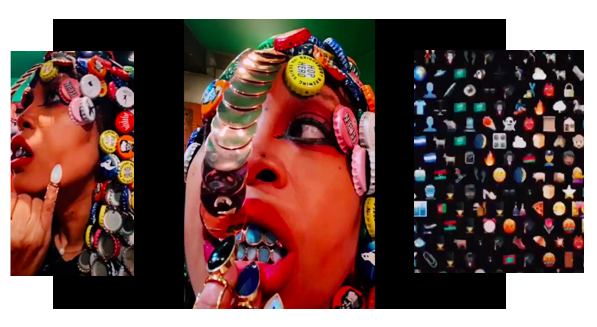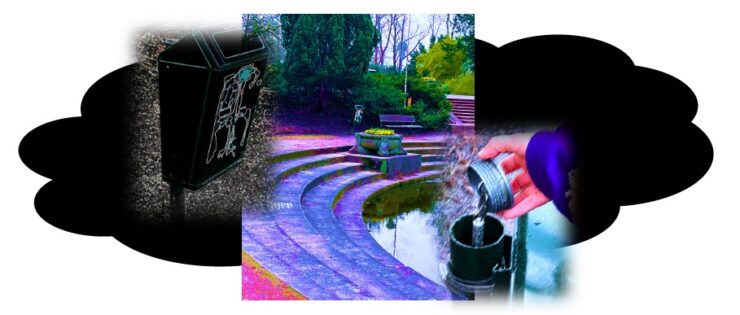[urban interfaces] Blogs
guest blogpost: Verena Kämpken – Urban Medi(t)ations: Low-tech magic trick transformations of the city
For our [urban interfaces] seminar series on the theme The Magic City (2021-2022), we invited participants to write blogposts. The best and most interesting ones we publish on our website.
Below is the blogpost for week 1, written by Verena Kämpken
With a background of a BA in Sociology and Human Geography from Goethe-University in Frankfurt, Verena Kämpken currently studies the research master Arts, Media and Literary Studies at RUG. She gravitates towards questions of STS, New Media/Critical Data Studies, New Materialisms and their intersections.
Urban Medi(t)ations: Low-tech magic trick transformations of the city
by Verena Kämpken
Critics of the techno-rationalist mindsets that inform modern imaginaries of the “smart city” often reference their description as “magical”, to characterize the solutions as disproportionally simple for the complexity of the problems they should solve. Maybe those are the Las-Vegas-cutting-a-woman-in-half-type-of-magic – the optical illusion ones – that get you faster from A to B, or which optimise bureaucracy/public services through digitization. But features typical for smart cities are probably not what comes to mind when considering the “magic city” as a place of enchantment. Experiences of the city that could be characterized as “magical” in that sense are assumedly rather sensual and emotionally intense than transactive, automated, rational flows. Federico Campagna, to whom Magic and Technic can be defined as contradictions to each other sees in Magic the potential to function “as a form of therapy to Technic’s brutal regime over that world, which it built in its own image” (Campagna 2018: 115-116). Technic’s perspective would account for “a paralysis of our ability to act and to imagine, and the crisis of our very sense of reality” (ibid.: 116). Emancipation from the limitations of technologized visions of urban futures might thus be what magic has to offer. Channelling magic in our cities could entail a new relating to them. It could “enact a more conscious (re-)creation of urban spaces, by creating ulterior ways of knowing and experiencing them, ways that disrupt and enrich their ‘normal’ understandings” (Bell 2019: 9). With nothing less on offer, how then can magic be embraced without resorting to what made us discard it or rather want to be free from it in the first place. What could be the role of magic in the city?
Since there is yet no fixed idea of the “magic city”, I would like to present some personal associations with it and try to make sense of it along the way.
Association #1: Urban Magic & Erykah Badu’s Meditation on Found Objects
Considering urban magic on a more abstract level, I first had to think of beloved artist Erykah Badu. To me, she represents the marriage of urbanity and magic perfectly by aesthetically fusing her fast cars, her Dallas accent, her hip-hop roots, her spiritually convincing performance as a goddess, her work as a doula. For those who are not familiar with her, I recommend this exemplary video of her “Meditation on Found Objects” in which she presents her wig made from repurposed bottlecaps (see Image 1).

FIGURE 1: Erykah Badu: Found Objects. A meditation on the use of what already exists in the creation of something new – the use of found objects, traded goods and recycled things. 09.01.2020. Online: https://www.youtube.com/watch?v=VxE4A34c8b8
What before was destined for landfills or trashcans, now has become a musical instrument worn as a glamourous headpiece. Erykah’s soulful voice blends together with bottlecap rattling and chiming gongs. Visually, the colourful pattern of the bottlecap wig blends together with a hieroglyphic pattern of emojis. Her creative amalgamations stimulate the senses like a massage.
Somehow her spirituality is accessible and contemporary, while avoiding notions of it that made us need to distance from it in the first place. Bearing the meaning of the “magic city” in mind, her referral to the process of repurposing objects as a meditation evokes urban activists’ calls to “reclaim the city”.
Association #2: Meditations on the city through Geocache’s treasure-hunting
While Erykah Badu’s artwork has possibly captured a representation of Urban Magic, particularly one that appeals to me personally, it remains unclear how this could relate to the city. A spatiality is lacking that illustrates the “magic city” and its potential. Her found objects or rather the process of finding objects in general evokes recollections of the few experiences I have had with Geocaching, the geographically coordinated hunt of “treasures” hidden in public spaces, a game that people play all over the world:
On the quest for my first cache a few years ago, I stood in the middle of a major German city where I had to stick my hand into the hole of a tree. There I find a tiny plastic container in which the classic piece of paper is sitting on which most Geocachers leave their signature or put their personalized stamp. My last searched cache, I found in the city in which I currently live. This time a metal capsule was attached to the pole cover of a public trashcan (see Image 2).
FIGURE 2: My Own: Place where a Geocache is hidden. Left: the trashcan. Middle: the location. Right: the capsule.
Never would I stick my hand into some tree in the city or would I inspect a public trashcan in such depth, if not for this activity. Through Geocaching you are transported to areas of the city you might not visit without the search. The perception of your surroundings is altered into a meditative, even psychedelic, adventure. You scan your environment, really taking it in, getting microscopically close to everything in it, suddenly contemplating how it was built and what has been put here. For example, the unsuccessfully removed remnants of posters and stickers on the trashcan’s front form a pattern, that in itself seems like a hieroglyph. Somehow it is beautiful.
Public places that before were boring, uncomfortable, or that wouldn’t invite me to notice them, are transformed into reasons for wonder and surprise. Herewith could the chance of magic lie: “The multiplicity of the unknown (and unknowable) city is not completely disempowering, for it grants imaginative spaces and enclaves for play, worship, and agency” (Bell 2019: 9). The cache functions like an interface or portal for engaging with the city in a new way that is not solely focused on its functionality and sometimes might even break the barriers of its assigned functions.
Potentials: Magic as reality therapy
The two cases each contribute interesting perspectives to what the notion of magic could mean. From found and repurposed objects to geocaching, the generative potential of magic as ‘reality-therapy’ is key: if Technic has reduced the contemporary to a state of annihilation, Magic could be understood as a reality-therapy. One which allows us to experiment with the “cosmogonic architecture of reality” (Campagna 2018: 117). Like an intervention, both the individual and his/her world could regain their presence and thus their mutually active and imaginative relationship through the act of, for example, “meditation”. The authors of “Urban Awakenings. Disturbance and Enchantment in the Industrial City” have found beautiful words to describe these qualities: “To look at the city anew, through the questioning lens of enchantment, is to do what therapists implore us to do through meditation: to fall awake” (Alexander/Gleeson 2020: 19). And we need to be awake if we want to realize the presence of the “here” and “now” despite their ineffability.
References
Alexander, Samuel/Gleeson, Brendan (2020): Urban Awakenings. Disturbance and Enchantment in the Industrial City. Singapore: Palgrave Macmillan.
Bell, Karl (2019): Supernatural Cities: Enchantment, Anxiety and Spectrality. Woodbridge: The Boydell Press.
Campagna, Federico (2018): Technic and Magic: The Reconstruction of Reality. London: Bloomsbury.


